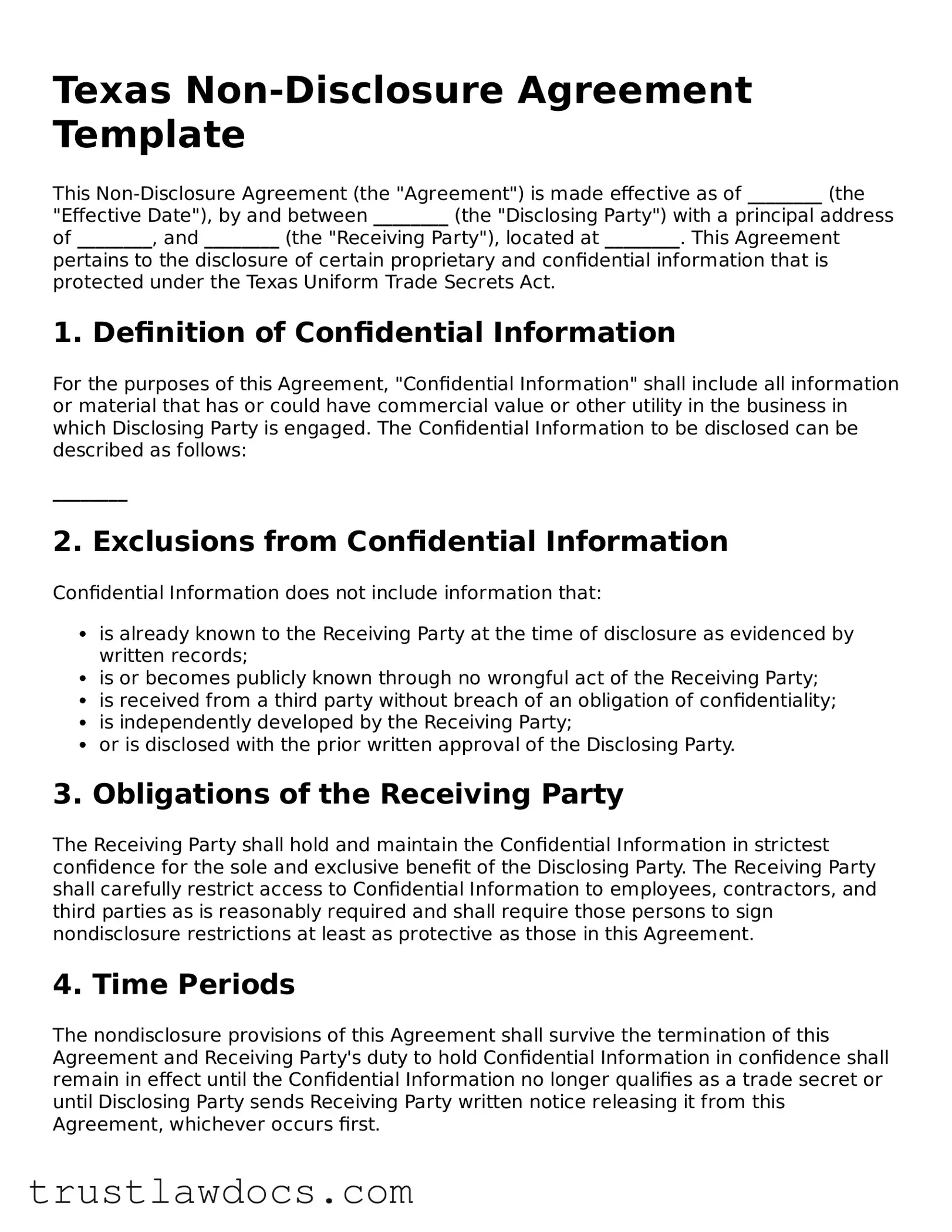Texas Non-Disclosure Agreement Template
This Non-Disclosure Agreement (the "Agreement") is made effective as of ________ (the "Effective Date"), by and between ________ (the "Disclosing Party") with a principal address of ________, and ________ (the "Receiving Party"), located at ________. This Agreement pertains to the disclosure of certain proprietary and confidential information that is protected under the Texas Uniform Trade Secrets Act.
1. Definition of Confidential Information
For the purposes of this Agreement, "Confidential Information" shall include all information or material that has or could have commercial value or other utility in the business in which Disclosing Party is engaged. The Confidential Information to be disclosed can be described as follows:
________
2. Exclusions from Confidential Information
Confidential Information does not include information that:
- is already known to the Receiving Party at the time of disclosure as evidenced by written records;
- is or becomes publicly known through no wrongful act of the Receiving Party;
- is received from a third party without breach of an obligation of confidentiality;
- is independently developed by the Receiving Party;
- or is disclosed with the prior written approval of the Disclosing Party.
3. Obligations of the Receiving Party
The Receiving Party shall hold and maintain the Confidential Information in strictest confidence for the sole and exclusive benefit of the Disclosing Party. The Receiving Party shall carefully restrict access to Confidential Information to employees, contractors, and third parties as is reasonably required and shall require those persons to sign nondisclosure restrictions at least as protective as those in this Agreement.
4. Time Periods
The nondisclosure provisions of this Agreement shall survive the termination of this Agreement and Receiving Party's duty to hold Confidential Information in confidence shall remain in effect until the Confidential Information no longer qualifies as a trade secret or until Disclosing Party sends Receiving Party written notice releasing it from this Agreement, whichever occurs first.
5. Law and Jurisdiction
This Agreement shall be governed by and construed in accordance with the laws of the State of Texas, without regard to its conflict of laws principles. Any disputes under this Agreement shall be handled in the state or federal courts located in Texas, and the Parties consent to the personal jurisdiction and venue of these courts.
6. Entire Agreement
This Agreement constitutes the entire agreement between the Parties regarding the subject matter hereof, superseding all prior agreements between the Parties concerning such subject matter. This Agreement may only be altered, amended, or revoked by a written amendment signed by both Parties.
Signatures
The Parties acknowledge and agree that:
- This Agreement has been duly executed and delivered by both Parties and constitutes a legal, valid, and binding obligation, enforceable in accordance with its terms;
- The signatories hereto are duly authorized to act on behalf of their respective Parties.
IN WITNESS WHEREOF, the Parties have executed this Agreement as of the Effective Date first above written.
Disclosing Party: ___________________________ Date: __________
Receiving Party: ___________________________ Date: __________
